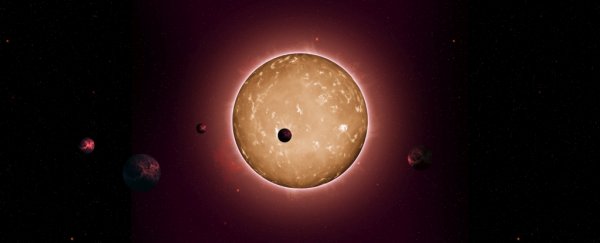After years of painstaking work, we're homing in on bringing the total of confirmed exoplanets – planets outside the Solar System – to a whopping 5,000.
In a major new haul for exoplanet studies, a team of astronomers has identified 366 previously unknown potential exoplanets in data from the retired Kepler space telescope.
The key was the development of an algorithm for identifying dips in stellar brightness that indicate the presence of an orbiting exoplanet.
"Discovering hundreds of new exoplanets is a significant accomplishment by itself, but what sets this work apart is how it will illuminate features of the exoplanet population as a whole," says astronomer Erik Petigura of the University of California, Los Angeles.
Kepler spent nearly a decade in an Earth-trailing orbit around the Sun, staring for long periods at patches of the sky, recording the stars. The aim was to capture faint dips in brightness that occur in a star's light when an exoplanet passes between us and the star. A series of regularly timed dips indicates the presence of an orbiting body.
The length of time between dips then allows astronomers to work out how closely the exoplanet is orbiting the star; the amount of light the exoplanet blocks reveals its size.
It all sounds very straightforward, but identifying the signals amidst the noise is long, painstaking work that used to be performed visually. That's because humans, traditionally, perform a lot better at signal detection than software.
But software is getting more sophisticated, and an algorithm developed by UCLA astronomer Jon Zink is helping pick up the slack. The research team fed all 500 terabytes of data from Kepler's second mission, covering over 800 million images, into the software. The result was 381 exoplanets that had been previously identified, and 366 potential exoplanets that were completely new.
Among the finds was a fascinating system containing two Saturn-like gas giants orbiting unusually closely to their host star, and each other. Planetary scientists look for unusual cases like this, because they allow us to understand the parameters of what's possible for planetary systems.
"The discovery of each new world provides a unique glimpse into the physics that play a role in planet formation," Zink explains.
Zink and his team were not the only scientists working on Kepler data. Another effort led by Hamed Valizadegan of the Universities Space Research Association (USRA) has added over 300 exoplanets to the list of those confirmed.
When a signal is identified as a potential exoplanet, it initially gets filed as a candidate. That is, it could be an exoplanet, but additional work is required in order to confirm it; astronomers need to rule out all other possibilities. The exoplanets discovered by Zink and his team fall into this category.
There are many thousands of exoplanet candidates. As of 18 November, the number of confirmed exoplanets was much lower, sitting at 4,575.
Valizadegan and colleagues have developed a deep neural network called ExoMiner that runs on NASA's Pleiades supercomputer. It can distinguish between a real exoplanet and false positives.
"When ExoMiner says something is a planet, you can be sure it's a planet," Valizadegan explained. "ExoMiner is highly accurate and in some ways more reliable than both existing machine classifiers and the human experts it's meant to emulate because of the biases that come with human labeling."
He and his team used ExoMiner to analyze candidate exoplanet data from the Kepler Archive. To be clear, these were exoplanets that had already been identified, but were awaiting confirmation. ExoMiner managed to confirm 301 of them.
None of these newly confirmed exoplanets are Earth-like, or in the potentially habitable zone of their solar systems, but they're important for understanding planetary system statistics in the Milky Way galaxy.
This helps us understand how planetary systems evolve and grow, and what the likely outcomes of system evolution are.
"Now that we've trained ExoMiner using Kepler data, with a little fine-tuning, we can transfer that learning to other missions, including TESS, which we're currently working on," Valizadegan said. "There's room to grow."
Each of the two papers alone is exciting, offering a refined set of tools to streamline the process of exoplanet hunting at different stages. Together, they offer a way to potentially automate the painstaking processes associated with identification and confirmation, freeing up scientists to work on interpretation and analysis of the exoplanets out there.
It's an excellent week for exoplanet research.
Zink's team's paper has been published in The Astronomical Journal, and Valizadegan's team's paper has been accepted into The Astrophysical Journal and is available on arXiv.
